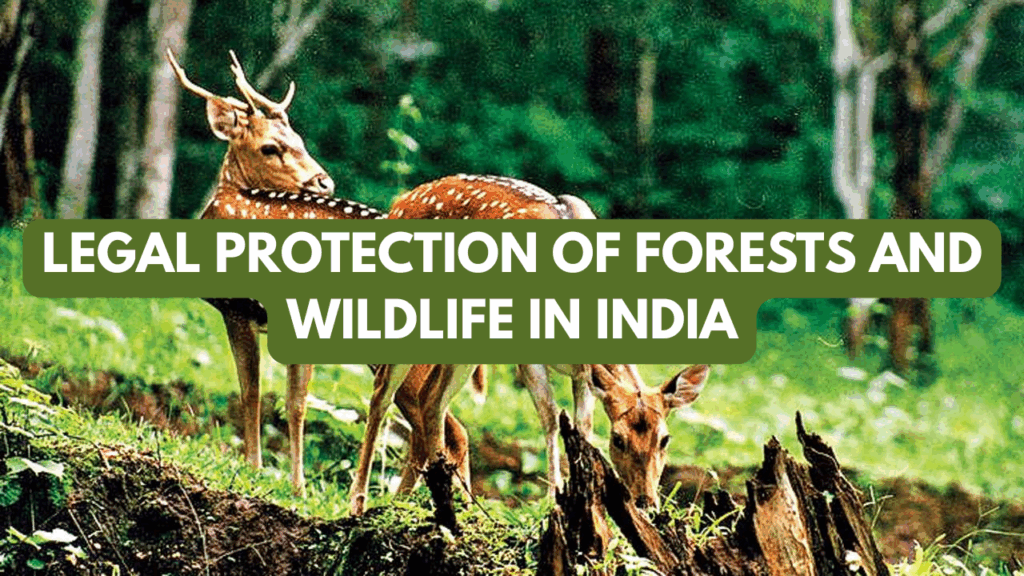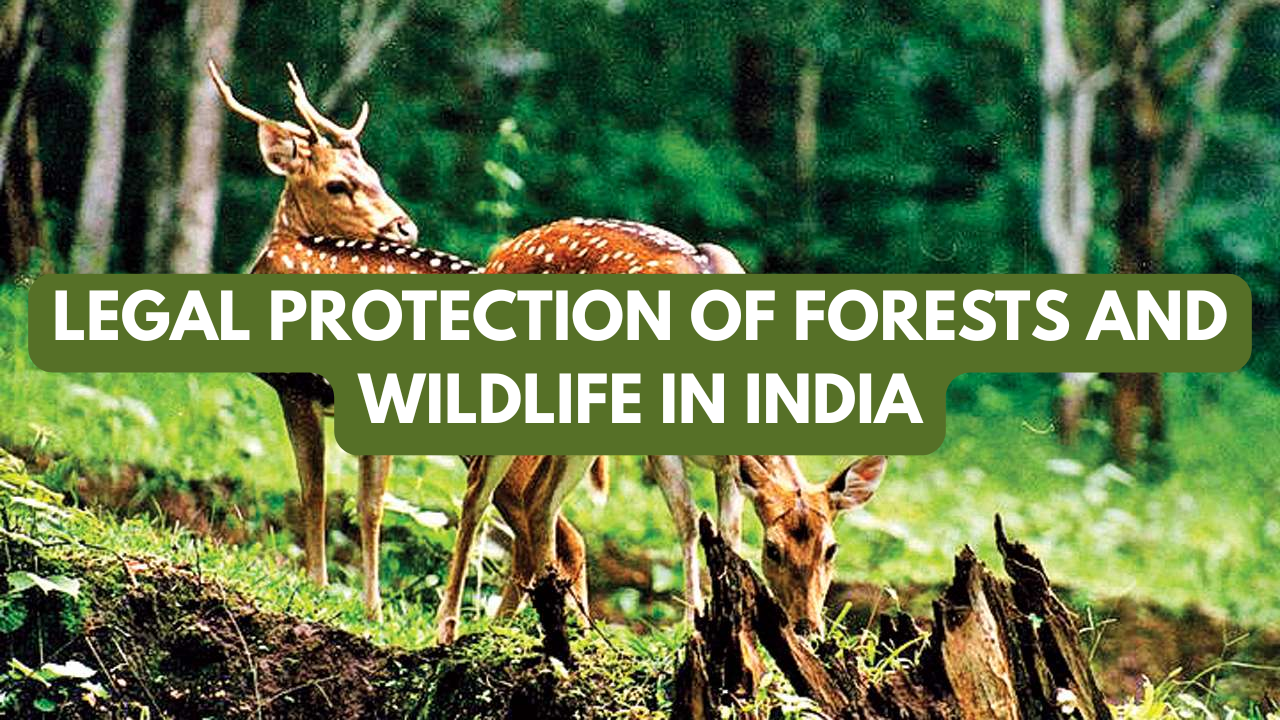
India is one of the world’s richest countries in terms of biodiversity, hosting forests that cover about 21% of its area and wildlife species that are globally significant. However, rapid industrialization, urbanization, and deforestation have posed serious threats to this natural wealth. To counter these challenges, India has developed a robust legal framework for the protection of forests and wildlife. From constitutional mandates to specialized legislations and judicial activism, the country has evolved a system that combines conservation with sustainable development.
Constitutional Provisions for Protection
- Directive Principles of State Policy (DPSP)
- Article 48A directs the State to protect and improve the environment and safeguard forests and wildlife.
- Fundamental Duties
- Article 51A(g) makes it the duty of every citizen to protect and improve the natural environment including forests, lakes, rivers, and wildlife.
- Concurrent List (Seventh Schedule)
- The 42nd Constitutional Amendment (1976) placed forests and wildlife under the Concurrent List, allowing both Centre and States to legislate.
Key Legislations for Forest and Wildlife Protection
1. Indian Forest Act, 1927
- Classified forests into Reserved, Protected, and Village forests.
- Empowered the government to regulate forest produce and impose restrictions.
2. Wildlife (Protection) Act, 1972
- Comprehensive law for the protection of wild animals, birds, and plants.
- Created Protected Areas such as National Parks, Wildlife Sanctuaries, and Tiger Reserves.
- Established schedules of species with varying levels of protection.
3. Forest (Conservation) Act, 1980
- Restricted diversion of forests for non-forest purposes without Central government approval.
- Ensured compensatory afforestation measures.
4. Biological Diversity Act, 2002
- Implemented the Convention on Biological Diversity (CBD).
- Provided for Biodiversity Boards and management of biological resources.
Judicial Contributions
The Supreme Court has played a proactive role in strengthening legal protection:
- T.N. Godavarman Thirumulpad v. Union of India (1996): Expanded the definition of forests and introduced continuous monitoring of forest conservation.
- Centre for Environmental Law, WWF v. Union of India (2013): Directed protection of critically endangered species.
- Wildlife First v. Union of India: Examined eviction of encroachers in forest areas vis-à-vis rights of forest dwellers.
Judicial activism has thus ensured strict compliance with environmental laws, even when executive agencies lagged.
Institutions Supporting Forest and Wildlife Protection
- National Board for Wildlife (NBWL): Apex advisory body for wildlife conservation.
- State Boards for Wildlife: Assist in state-level policies.
- Wildlife Crime Control Bureau (WCCB): Specialized agency to curb illegal wildlife trade.
- Forest Departments: Enforce forest laws at the state level.
- National Green Tribunal (NGT): Provides speedy justice in environmental disputes.
Challenges in Legal Protection
- Human–Wildlife Conflict due to shrinking habitats and urban expansion.
- Illegal Trade in wildlife parts, poaching, and smuggling.
- Development Pressure leading to diversion of forests for mining, dams, and infrastructure.
- Weak Enforcement due to lack of resources in state forest departments.
- Balancing Rights of indigenous communities with conservation efforts.
Overview Table
| Aspect | Key Legal Provisions | Impact/Outcome | Challenges |
|---|---|---|---|
| Constitutional Mandate | Articles 48A, 51A(g), 42nd Amendment | Made conservation a state and citizen duty | Enforcement and awareness gaps |
| Forest Protection | Indian Forest Act, 1927; Forest (Conservation) Act, 1980 | Regulated diversion, protected reserves | Conflict with development needs |
| Wildlife Protection | Wildlife (Protection) Act, 1972 | Creation of sanctuaries, species protection | Poaching, illegal trade |
| Biodiversity Conservation | Biological Diversity Act, 2002 | Community involvement in conservation | Weak implementation at local level |
| Judicial Interventions | Godavarman, WWF cases | Expanded scope of forest & wildlife protection | Delays in compliance |
| Institutions | NBWL, WCCB, NGT, Forest Departments | Strengthened governance mechanisms | Capacity constraints |
The Way Forward
- Community Participation: Greater involvement of local communities and tribal groups in conservation programs.
- Technology Integration: Use of GIS, drones, and satellite monitoring for better forest and wildlife management.
- Stricter Enforcement: Strengthening institutions like WCCB and SPCBs to curb illegal activities.
- Balancing Development and Conservation: Clear environmental impact assessments to avoid unsustainable projects.
- Awareness Campaigns: Educating citizens about their constitutional duties in protecting forests and wildlife.
Conclusion
India’s legal framework for protecting forests and wildlife is among the most comprehensive globally. Constitutional provisions, strong legislation, and proactive judiciary have created a robust system. However, effective implementation remains a challenge due to competing developmental pressures and resource limitations. The future of India’s forests and wildlife depends on strengthening governance, empowering local communities, and ensuring strict enforcement so that ecological balance and sustainable development go hand in hand.
FAQs
Q1. Which is the most important law for wildlife protection in India?
The Wildlife (Protection) Act, 1972 is the primary legislation for protecting animals, birds, and plants.
Q2. How does the Forest (Conservation) Act, 1980 protect forests?
It restricts diversion of forest land for non-forest purposes without Central approval and mandates compensatory afforestation.
Q3. What role does the judiciary play in protecting forests and wildlife?
Through landmark judgments, the Supreme Court has expanded definitions, monitored compliance, and directed stronger protections.

